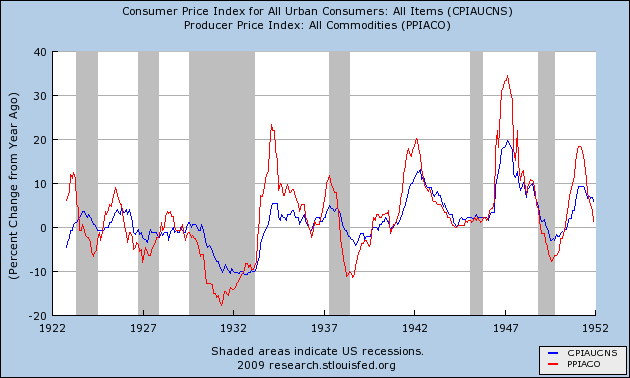This morning the BLS reported that consumer inflation rose +0.4%(seasonally adjusted) in August, up +0.2% NSA. While year-over-year prices are still - 1.5% into deflation, this is an increase from last month's bottom of -2.1%.
The deflationary bust of early 2009 unfolded in accord with the optimistic scenario I laid out in January:
In the Optimistic scenario, the fiscal and monetary stimuli, together with intelligent new political leadership in Washington, halt the meltdown perhaps by mid-year, and wage reductions remain the exception. In the Pessimistic scenario, the stimuli fail, and wage reductions spread, leading to a wage-price deflationary spiral.
In the Optimistic scenario, monthly inflation remains positive, but perhaps at 1/3 to 1/2 the level of last year. By the end of June, first half 2009 inflation will be in the 1.4%-2.2% range. Year over year, however, as the 2008 numbers are replaced, DEflation will be realized, falling to (-2.0%) - (-2.7%) range....
In the Pessimistic scenario, monthly inflation remains near 0%-1% in the first half, and is firmly negative, though less than 2008 in the second half. By mid-year, YoY DEflation will be somewhere in the (-3%) - (-4.5%) range....
In the pre-World War 2 era of deflationary busts, including the Great Depression, PPI for commodities bottomed and turned around either before or simultaneously with CPI. when YoY CPI bottomed, the bust ended. Such a bottom coincided with increased demand. Here is the consumer and commodity inflation data during the deflationary 1920-1950 era demonstrating this point:

Note that commodities (in red) almost always turned up before the economy as a whole did. Typically CPI (in blue) bottomed on a year-over-year basis at the end of deflationary recessions, including the Great Depression.
By August, YoY commodity deflation, producer deflation, and now consumer inflation have all bottomed, signalling by pre-WW2 metrics of deflationary busts, that global consumer demand has increased, and thus the recession has indeed ended, as Fed Chair Ben Bernanke opined yesterday.
Food inflation has also turned around:
The food index rose 0.1 percent
following a 0.3 percent decline in July. The food at home index,
which fell 0.5 percent in July, was unchanged in August.
Food has declined for 5 of the last 6 months, and is now only up 0.4% YoY.
It is noteworthy that 2 of the 5 coincident indicators known to be used by members of the NBER to date the end of recessions -- real retail sales and industrial production -- have increased, and 2 others -- personal income and aggregate hours work -- appear to have bottomed, consistent with the pre-WW2 deflationary bust scenario outlined above. Only jobs have yet to turn around.